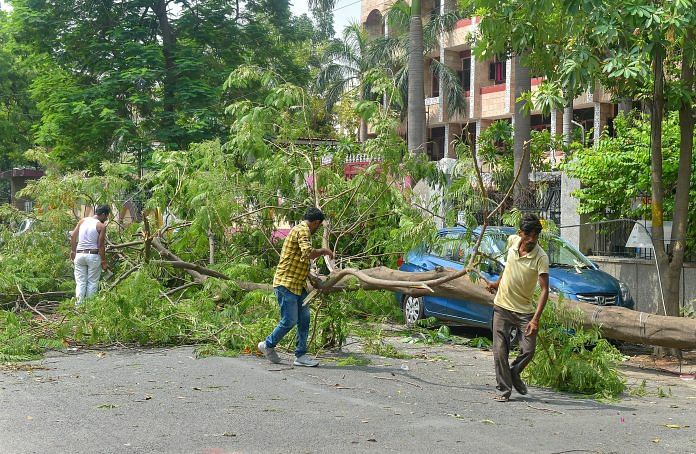ThePrint had recently reported that the AAP administration had not rejected a single request to cut trees since assuming office in 2015.
New Delhi: The Aam Aadmi Party (AAP)-led Delhi government may have scored one against the Centre by cornering it over a plan to cut down more than 16,500 trees for redevelopment projects, but its own record is far from green.
Approximately the same number of trees have been cut in Delhi’s non-forest area since the Arvind Kejriwal government was sworn in, with every single request for tree-felling since 2015 approved by the administration.
According to records maintained by Delhi’s forest department, the administration has allowed the felling of over 17,115 trees in its north, south, and west zones. While not one application has been denied, several remain pending.
Delhi environment and forest minister Imran Hussain’s office did not respond when contacted by ThePrint for comment. However, several AAP supporters, including MLA Saurabh Bharadwaj, said the lieutenant governor (L-G) had signed on these requests, and not the government.
Although the L-G’s nod is necessary for requests to fell trees in areas measuring over one hectare, the forest department is empowered to permit requests pertaining to a smaller area.
Two days after an earlier version of this story was first published, a report said Hussain had exercised powers the AAP claimed he did not have to revoke permissions granted for trees yet to be felled.
The numbers
In 2015 alone, 8,889 trees were allowed to be cut. The number fell to 3,580 in 2016, of which 1,700 trees were to be cut in the Pragati Maidan area for redevelopment. In 2017, the number of permissions granted again rose, to 4,646.
Over 44 per cent of the trees cut were in the north zone that covers east, north-east, and north Delhi. However, the figure for the north zone may not be entirely accurate since, in many instances, the entry on the number of trees permitted to be cut is simply noted as “some trees” or as “one plus some trees”. While data maintained for the south zone also records the number of requests made, no such entry exists for the other two zones.
The forest department’s data does not categorise requests for tree-felling based on the size of the area for which permission is sought, but an attempt can be made to determine where the nod may have come from.
For example, of the 77 requests made in 2017-18, over 25 were made by private parties for residential purposes, and they are unlikely to have had plots of over one hectare in Delhi.
Significantly, this excludes requests made by former public servants and Army officials for their private residences. For example, Delhi chief minister Sheila Dikshit’s request to cut a tree at her private residence in Nizamuddin East is listed under the category ‘government’.
In 2016-17, 44 of the 95 requests were made by private individuals in the south zone for residential purposes. In the west zone, 44 of 110 such requests were by private individuals. The north zone, however, has no such category in its records.
Environmentalists have criticised the rampant felling of trees in the city, often filing petitions before the National Green Tribunal. Last week, the Delhi-based non-profit Society for Protection of Culture, Heritage, Environment, Traditions & Promotion of National Awareness (CHETNA) moved the green court against the Centre’s decision to cut 16,500 trees for redevelopment projects that included building accommodation for government employees and a commercial space.
“The problem is that India’s statutory bodies that should be actively protecting the environment have largely become just bodies that give clearances and permissions according to a checklist,” said Vimlendu Jha, a Delhi-based environmentalist.
Jha, also a member of the Ridge Development Authority, a body formed by the NGT to protect Delhi’s ecologically sensitive ridge areas, added that felling of trees was rampant even in the ridge’s forest area despite stringent laws.
“The state government’s posturing on this issue is only to make a political point. No government takes these issues with the seriousness it requires,” Jha said.
The felling of so many trees in Delhi at once evoked an emotive response from the residents of a city besieged by endemic severe air pollution, as a robust green cover is often offered as the first solution to tackling such a crisis.
How do you get a licence to fell?
Cutting a tree in Delhi is no simple affair. According to the Delhi Preservation of Trees Act, 1994, any person or government agency has to seek the forest department’s nod and pay a hefty fee for felling, pruning, transplanting, pollarding or lopping a tree.
A request is made to the tree officer along with details of a given piece of land’s ownership, the number and kind of trees to be cut, their girth, and the reason for the application.
After an initial scrutiny, the tree officer assigns an inspection officer to examine the request and file a report. Based on the report, permission is granted after the fee is paid. In 2015, the fee to cut each tree was Rs 34,500, with a refundable deposit of Rs 15,000 for an individual applicant, and Rs 57,000 for each tree with a refundable component of Rs 25,000 for commercial projects.
The refundable deposits are used to ensure compensatory replanting of trees.
An earlier version of this copy was published on 2 July.



